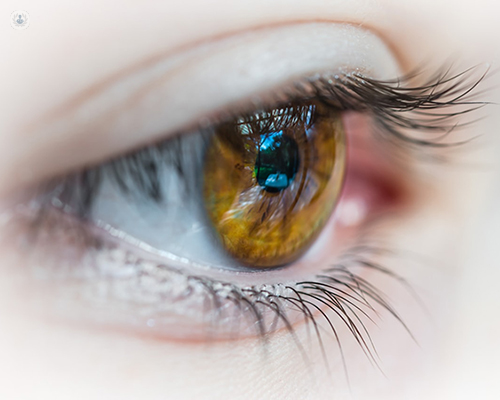Minimally-invasive laser eye treatment for floaters
Escrito por:Those squiggly lines, small specks and shapes that often look like cobwebs, which dart away when you try to see them more clearly, are called eye floaters. In the vast majority of patients, these are a minor irritation with no need for treatment. However, there is increasing recognition in scientific studies that floaters can have a serious impact on a patient’s vision and quality of life.
Thankfully, laser eye treatment known as YAG laser vitreolysis is a minimally-invasive, pain-free procedure that can dramatically reduce the visual disturbance caused by floaters. Here, one of our top ophthalmologists Mr Vaughan Tanner explains everything that you need to know about the procedure, including what happens during the treatment.

What is YAG vitreolysis?
Laser treatment has improved significantly in recent years with much better laser focusing, which allows for safer treatment. Vitreolysis involves the application of nanosecond pulses of laser light to vaporise the vitreous opacities and to cut vitreous strands. Laser vitreolysis uses a Neodymium: Yttrium-Aluminium Garnet (Nd: YAG) laser to vaporise the floaters within the eye.
The end result is that the floater is either removed or reduced to a size that no longer impedes vision.
Who is suitable for vitreolysis?
Patients over the age of 45 are usually the best candidates. Younger patients tend to have microscopic floaters located close to the retina, which is not considered ideal for vitreolysis treatment. The procedure is usually offered to patients who have had persistent symptoms for more than six months and who have large, well-defined floaters that sit away from the retina.
What happens during the procedure?
Vitreolysis is a day case procedure, which means that you do not have to stay overnight in a hospital. Prior to treatment, you will have anaesthetic eye drops administered. A contact lens is placed on your eye with the laser light delivered through a specifically designed laser microscope.
The laser is carefully aimed at either the floaters or their attachments. During treatment, the patient will see small, dark specks, which are the floaters being vaporised into small gas bubbles. These bubbles quickly dissolve into the vitreous.
The treatment session takes between 10-30 minutes but depends on the size and extent of the floaters. Most patients will need to undergo two to three treatment sessions to achieve a satisfactory result as it is not possible to eliminate all floaters in one sitting.
What can I expect after YAG vitreolysis treatment?
Some patients may experience mild discomfort, redness or temporarily blurred vision immediately after treatment. There may be small, dark specks in the lower field of vision straight after the procedure, which are gas bubbles that will quickly dissolve.
Are there any complications and side effects?
The reported side effects and complications associated with vitreolysis are rare. Possible complications may include the development of cataract, retinal damage, intraocular pressure (IOP) spike and potential loss of vision (less than 1%).
If floaters persist following vitreolysis, the patient may want to consider surgical vitrectomy. Surgery is very effective but more invasive with a higher risk of problems.
Read more on vitrectomy surgery
If you would like to discuss your treatment options for floaters, you can book an appointment with Mr Tanner via his Top Doctor’s profile.


